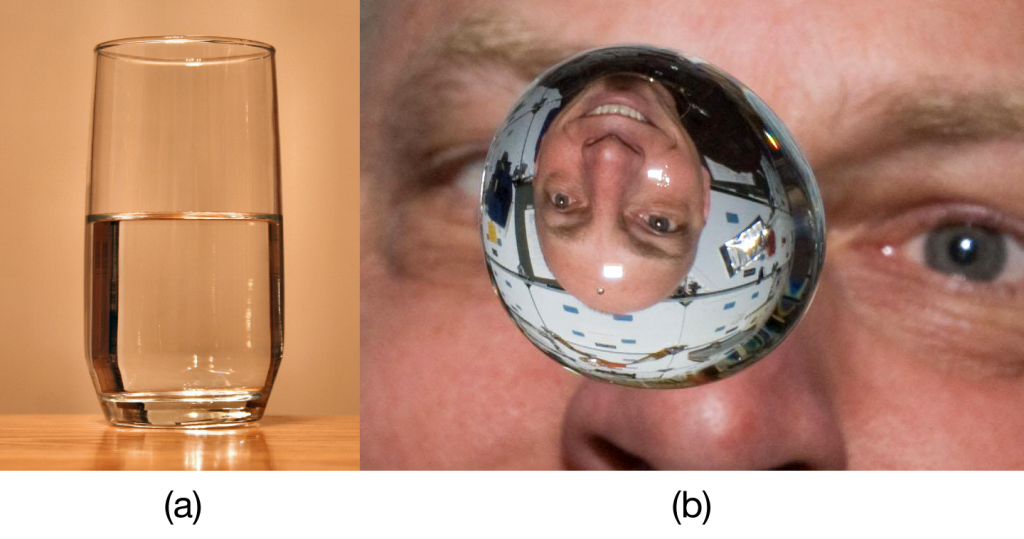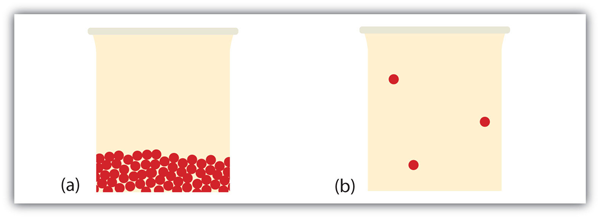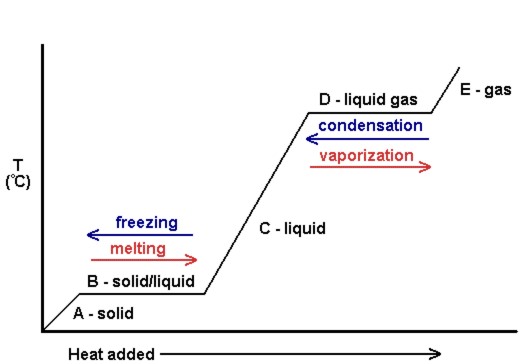How Is The Kinetic Energy Of The Particles Of A Substance Affected During A Phase Change?
Chapter x. Solids and Liquids
Phase Transitions: Melting, Humid, and Subliming
- Describe what happens during a phase change.
- Calculate the free energy alter needed for a phase change.
Substances can change phase — often because of a temperature change. At low temperatures, about substances are solid; as the temperature increases, they become liquid; at higher temperatures notwithstanding, they become gaseous.
The process of a solid becoming a liquid is called melting (an older term that you may see sometimes is fusion). The opposite process, a liquid becoming a solid, is called solidification. For any pure substance, the temperature at which melting occurs — known as the melting point — is a feature of that substance. It requires energy for a solid to melt into a liquid. Every pure substance has a certain corporeality of energy it needs to modify from a solid to a liquid. This amount is called the enthalpy of fusion (or estrus of fusion) of the substance, represented as ΔH fus. Some ΔH fus values are listed in Table 10.2 "Enthalpies of Fusion for Diverse Substances"; it is assumed that these values are for the melting signal of the substance. Note that the unit of ΔH fus is kilojoules per mole, so we need to know the quantity of material to know how much free energy is involved. The ΔH fus is always tabulated as a positive number. However, it can be used for both the melting and the solidification processes as long as you keep in heed that melting is always endothermic (then ΔH volition exist positive), while solidification is always exothermic (then ΔH will be negative).
| Substance (Melting Point) | ΔH fus (kJ/mol) |
|---|---|
| Water (0°C) | 6.01 |
| Aluminum (660°C) | x.vii |
| Benzene (v.v°C) | 9.95 |
| Ethanol (−114.iii°C) | five.02 |
| Mercury (−38.viii°C) | two.29 |
What is the energy change when 45.vii chiliad of HtwoO melt at 0°C?
Solution
The ΔH fus of H2O is half-dozen.01 kJ/mol. Yet, our quantity is given in units of grams, not moles, so the first step is to convert grams to moles using the tooth mass of H2O, which is 18.0 g/mol. And then we can use ΔH fus as a conversion cistron. Because the substance is melting, the process is endothermic, then the energy change will take a positive sign.
![]()
Without a sign, the number is assumed to exist positive.
Test Yourself
What is the energy change when 108 thou of C6Hhalf dozen freeze at 5.5°C?
Answer
−thirteen.viii kJ
During melting, energy goes exclusively to irresolute the phase of a substance; it does not go into changing the temperature of a substance. Hence melting is an isothermal process because a substance stays at the aforementioned temperature. Only when all of a substance is melted does any additional free energy go to changing its temperature.
What happens when a solid becomes a liquid? In a solid, individual particles are stuck in place because the intermolecular forces cannot be overcome by the free energy of the particles. When more energy is supplied (e.g., by raising the temperature), there comes a point at which the particles accept enough energy to move around only non enough energy to separate. This is the liquid phase: particles are even so in contact but are able to move around each other. This explains why liquids tin assume the shape of their containers: the particles move around and, under the influence of gravity, fill the lowest book possible (unless the liquid is in a zero-gravity environment — meet Figure 10.16 "Liquids and Gravity").

The phase change between a liquid and a gas has some similarities to the phase change between a solid and a liquid. At a sure temperature, the particles in a liquid have plenty energy to go a gas. The process of a liquid condign a gas is chosen boiling (or vapourization), while the procedure of a gas condign a liquid is called condensation. However, dissimilar the solid/liquid conversion process, the liquid/gas conversion procedure is noticeably affected past the surrounding pressure on the liquid considering gases are strongly affected past pressure. This means that the temperature at which a liquid becomes a gas, the boiling point, tin change with surrounding pressure. Therefore, nosotros ascertain the normal boiling indicate as the temperature at which a liquid changes to a gas when the surrounding pressure is exactly i atm, or 760 torr. Unless otherwise specified, it is assumed that a boiling point is for 1 atm of pressure.
Similar the solid/liquid stage change, the liquid/gas stage alter involves free energy. The amount of free energy required to convert a liquid to a gas is called the enthalpy of vaporization (or rut of vaporization), represented every bit ΔH vap. Some ΔH vap values are listed in Tabular array 10.3 "Enthalpies of Vaporization for Diverse Substances"; information technology is assumed that these values are for the normal boiling signal temperature of the substance, which is besides given in the table. The unit for ΔH vap is also kilojoules per mole, so we need to know the quantity of material to know how much energy is involved. The ΔH vap is as well always tabulated as a positive number. It can be used for both the boiling and the condensation processes as long as you keep in mind that boiling is always endothermic (so ΔH will be positive), while condensation is e'er exothermic (so ΔH volition be negative).
| Substance (Normal Boiling Betoken) | ΔH vap (kJ/mol) |
|---|---|
| Water (100°C) | 40.68 |
| Bromine (59.5°C) | 15.four |
| Benzene (80.one°C) | 30.8 |
| Ethanol (78.three°C) | 38.6 |
| Mercury (357°C) | 59.23 |
What is the energy change when 66.seven g of Brtwo(g) condense to a liquid at 59.5°C?
Solution
The ΔH vap of Br2 is 15.4 kJ/mol. Even though this is a condensation process, we can notwithstanding utilise the numerical value of ΔH vap as long as we realize that we must accept energy out, so the ΔH value will exist negative. To determine the magnitude of the energy change, we must starting time convert the amount of Br2 to moles. Then we can apply ΔH vap every bit a conversion factor.
![]()
Because the procedure is exothermic, the bodily value will be negative: ΔH = −6.43 kJ.
Examination Yourself
What is the energy modify when 822 g of C2H5OH(ℓ) eddy at its normal boiling bespeak of 78.three°C?
Respond
689 kJ
As with melting, the free energy in boiling goes exclusively to changing the phase of a substance; information technology does not go into changing the temperature of a substance. So humid is also an isothermal process. Merely when all of a substance has boiled does any boosted energy go to changing its temperature.
What happens when a liquid becomes a gas? We have already established that a liquid is equanimous of particles in contact with each other. When a liquid becomes a gas, the particles divide from each other, with each particle going its ain way in space. This is how gases tend to fill up their containers. Indeed, in the gas phase nigh of the book is empty space; merely most one 1-thousandth of the volume is actually taken upwardly by affair (encounter Figure 10.17 "Liquids and Gases"). It is this property of gases that explains why they can be compressed, a fact that is considered in Chapter 6 "Gases".

Nether some circumstances, the solid phase can transition straight to the gas phase without going through a liquid phase, and a gas tin can directly become a solid. The solid-to-gas change is chosen sublimation, while the reverse process is called degradation. Sublimation is isothermal, like the other phase changes. There is a measurable energy change during sublimation; this free energy change is called the enthalpy of sublimation, represented equally ΔH sub. The relationship betwixt the ΔH sub and the other enthalpy changes is as follows:
ΔH sub = ΔH fus + ΔH vap
As such, ΔH sub is not ever tabulated because it can exist merely calculated from ΔH fus and ΔH vap.
In that location are several common examples of sublimation. A well-known product — dry water ice — is actually solid CO2. Dry ice is dry because it sublimes, with the solid bypassing the liquid phase and going straight to the gas phase. The sublimation occurs at temperature of −77°C, then it must be handled with caution. If you have e'er noticed that ice cubes in a freezer tend to get smaller over time, it is because the solid water is very slowly subliming. "Freezer burn" isn't really a fire; information technology occurs when sure foods, such equally meats, slowly lose solid water content because of sublimation. The food is still good but looks unappetizing. Reducing the temperature of a freezer will slow the sublimation of solid water.
Chemical equations can be used to represent a stage change. In such cases, it is crucial to apply stage labels on the substances. For case, the chemic equation for the melting of ice to make liquid water is every bit follows:
H2O(south) → H2O(ℓ)
No chemic change is taking place; notwithstanding, a physical change is taking identify.
Heating Curves
A plot of the temperature versus the amount of rut added is known every bit a heating curve (see Figure 10.18). These are unremarkably used to visually show the relationship betwixt phase changes and enthalpy for a given substance.

In Figure 10.18[1], the solid gains kinetic free energy and consequently rises in temperature every bit heat is added. At the melting point, the heat added is used to break the attractive intermolecular forces of the solid instead of increasing kinetic energy, and therefore the temperature remains abiding. Later on all the solid has melted, once more, the heat added goes to increasing the kinetic energy (and temperature) of the liquid molecules until the boiling indicate. At the boiling point, once again, the rut added is used to interruption the attractive intermolecular forces instead of supplying kinetic energy, and the temperature remains constant until all liquid has been turned to gas.
- Stage changes can occur between any two phases of matter.
- All phase changes occur with a simultaneous change in energy.
- All phase changes are isothermal.
Questions
- What is the departure betwixt melting and solidification?
- What is the difference between boiling and condensation?
- Depict the molecular changes when a solid becomes a liquid.
- Depict the molecular changes when a liquid becomes a gas.
- What is the energy change when 78.0 g of Hg melt at −38.8°C?
- What is the free energy change when 30.8 m of Al solidify at 660°C?
- What is the free energy change when 111 g of Brtwo boil at 59.v°C?
- What is the energy change when 98.6 g of H2O condense at 100°C?
- Each of the following statements is wrong. Rewrite them so they are correct.
- Temperature changes during a phase alter.
- The procedure of a liquid condign a gas is chosen sublimation.
- Each of the following statements is incorrect. Rewrite them so they are correct.
- The book of a gas contains only most x% matter, with the residual being empty space.
- ΔH sub is equal to ΔH vap.
- Write the chemic equation for the melting of elemental sodium.
- Write the chemical equation for the solidification of benzene (C6Hsix).
- Write the chemical equation for the sublimation of COii.
- Write the chemical equation for the boiling of propanol (C3H7OH).
- What is the ΔH sub of H2O? (Hint: see Table 10.2 "Enthalpies of Fusion for Various Substances" and Table 10.3 "Enthalpies of Vaporization for Various Substances".)
- The ΔH sub of I2 is 60.46 kJ/mol, while its ΔH vap is 41.71 kJ/mol. What is the ΔH fus of I2?
Answers
- Melting is the phase change from a solid to a liquid, whereas solidification is the phase change from a liquid to a solid.
- The molecules take enough energy to move about each other simply non plenty to completely separate from each other.
- 890 J
- 10.vii kJ
-
- Temperature does not change during a phase change.
- The procedure of a liquid becoming a gas is called boiling; the procedure of a solid becoming a gas is called sublimation.
- Na(s) → Na(ℓ)
- COii(due south) → CO2(g)
- 46.69 kJ/mol
Media Attributions
- "Drinking glass of H2o" © 2005 by Derek Jensen is licensed under a Public Domain license
- "Clayton Anderson zero g" © 2010 by NASA is licensed nether a Public Domain license
Source: https://opentextbc.ca/introductorychemistry/chapter/phase-transitions-melting-boiling-and-subliming/
Posted by: smithprame1944.blogspot.com


0 Response to "How Is The Kinetic Energy Of The Particles Of A Substance Affected During A Phase Change?"
Post a Comment